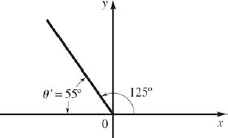8.2. Finding the Angle When the Trigonometric Function Is Known
Given an angle, we can find its trigonometric functions. Now we reverse the operation and find the angle when given the trigonometric function. We did the same in Chap. 7 with acute angles, but here we will see that it is slightly more complicated with angles greater than 90°.
▪ Exploration: Try this.
Use your calculator to find the following:
- sin 35° sin 145° sin 395°
What did you find? Can you explain your findings?
Now find the angle whose sine is 0.573576. What can you say about your result?
When you took the sine of an angle, you got a single answer. But your exploration should have shown you that there is more than one angle that has the same sine (or cosine and tangent). In fact, there are infinitely many, if you count angles greater than one revolution. So how do we find the one that we need? We use something called the reference angle.
Figure 8.10. Reference angle θ′. It is also called the working angle.

8.2.1. Reference Angle
For an angle in standard position on coordinate axes, the acute angle that its terminal side makes with the x axis is called the reference angle,. It is always taken as positive.
Example 10:The reference angle θ′ for an angle of 125° is
as shown in Fig. 8-10. |
Example 11:The reference angle θ′ for an angle of 236° is
as in Fig. 8-11 |
Get Technical Mathematics, Sixth Edition now with the O’Reilly learning platform.
O’Reilly members experience books, live events, courses curated by job role, and more from O’Reilly and nearly 200 top publishers.

